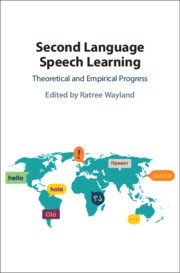Book contents
- Second Language Speech Learning
- Second Language Speech Learning
- Copyright page
- Dedication
- Contents
- Figures
- Tables
- Contributors
- Preface
- Acknowledgments
- Part I Theoretical Progress
- Part II Segmental Acquisition
- Part III Acquiring Suprasegmental Features
- Chapter 9 Relating Production and Perception of L2 Tone
- Chapter 10 Production of Mandarin Tones by L1-Spanish Early Learners in a Classroom Setting
- Chapter 11 Production of English Lexical Stress by Arabic Speakers
- Chapter 12 Variability in Speaking Rate of Native and Nonnative Speech
- Part IV Accentedness and Acoustic Features
- Part V Cognitive and Psychological Variables
- Index
- References
Chapter 10 - Production of Mandarin Tones by L1-Spanish Early Learners in a Classroom Setting
from Part III - Acquiring Suprasegmental Features
Published online by Cambridge University Press: 21 January 2021
- Second Language Speech Learning
- Second Language Speech Learning
- Copyright page
- Dedication
- Contents
- Figures
- Tables
- Contributors
- Preface
- Acknowledgments
- Part I Theoretical Progress
- Part II Segmental Acquisition
- Part III Acquiring Suprasegmental Features
- Chapter 9 Relating Production and Perception of L2 Tone
- Chapter 10 Production of Mandarin Tones by L1-Spanish Early Learners in a Classroom Setting
- Chapter 11 Production of English Lexical Stress by Arabic Speakers
- Chapter 12 Variability in Speaking Rate of Native and Nonnative Speech
- Part IV Accentedness and Acoustic Features
- Part V Cognitive and Psychological Variables
- Index
- References
Summary
This study investigated the production of the four Mandarin tones by a group of school-aged Spanish learners of Chinese (n=12) and a group of native Chinese children (n=4) with a mean age of 9.5 years. The participants were recorded in a quiet room at the school premises while performing an imitation task in which they produced 32 monosyllabic words embedded in a carrier phrase. Time-normalized pitch contours were extracted at 20 consecutive points, converted to logarithmic Z-scores to normalize F0 variation across talkers and submitted to growth curve analysis to compare the surface F0 contours of the four tones. A significant difference in the F0 shapes produced by the two groups was found for all four tones, but a significant difference in F0 height was found only for Tones 2 and 3. The findings suggested that native-like production of pitch contour may be more challenging than pitch height due to their relatively more complex f0-related laryngeal muscle activities and lesser attention to the former than the latter F0 dimension among non-native tone listeners.
- Type
- Chapter
- Information
- Second Language Speech LearningTheoretical and Empirical Progress, pp. 273 - 289Publisher: Cambridge University PressPrint publication year: 2021



